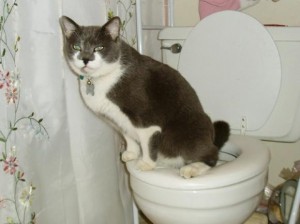Reasons You Should Never Flush Cat Poop Down Your Toilet - Critical Information
Reasons You Should Never Flush Cat Poop Down Your Toilet - Critical Information
Blog Article
The article below on the subject of How to Dispose of Cat Poop and Litter Without Plastic Bags is relatively entertaining. Try it and make your own results.

Intro
As feline owners, it's important to bear in mind exactly how we get rid of our feline pals' waste. While it may seem convenient to purge pet cat poop down the bathroom, this practice can have detrimental repercussions for both the environment and human wellness.
Ecological Impact
Purging pet cat poop introduces harmful microorganisms and parasites into the supply of water, posturing a considerable risk to water environments. These pollutants can negatively influence aquatic life and concession water top quality.
Wellness Risks
Along with environmental issues, flushing feline waste can likewise position wellness threats to people. Feline feces might consist of Toxoplasma gondii, a parasite that can cause toxoplasmosis-- a potentially extreme ailment, specifically for pregnant females and people with weakened immune systems.
Alternatives to Flushing
Luckily, there are safer and more liable methods to dispose of pet cat poop. Consider the complying with alternatives:
1. Scoop and Dispose in Trash
The most common approach of taking care of feline poop is to scoop it right into a naturally degradable bag and throw it in the garbage. Make certain to utilize a dedicated clutter scoop and get rid of the waste without delay.
2. Use Biodegradable Litter
Select eco-friendly pet cat litter made from materials such as corn or wheat. These clutters are eco-friendly and can be securely disposed of in the trash.
3. Hide in the Yard
If you have a backyard, consider hiding feline waste in a designated location away from veggie yards and water sources. Be sure to dig deep sufficient to stop contamination of groundwater.
4. Install a Pet Waste Disposal System
Invest in a pet dog waste disposal system particularly developed for pet cat waste. These systems utilize enzymes to break down the waste, minimizing smell and ecological influence.
Conclusion
Responsible family pet ownership expands beyond providing food and shelter-- it likewise involves appropriate waste administration. By refraining from purging feline poop down the commode and choosing different disposal techniques, we can reduce our environmental impact and safeguard human health.
Why Can’t I Flush Cat Poop?
It Spreads a Parasite
Cats are frequently infected with a parasite called toxoplasma gondii. The parasite causes an infection called toxoplasmosis. It is usually harmless to cats. The parasite only uses cat poop as a host for its eggs. Otherwise, the cat’s immune system usually keeps the infection at low enough levels to maintain its own health. But it does not stop the develop of eggs. These eggs are tiny and surprisingly tough. They may survive for a year before they begin to grow. But that’s the problem.
Our wastewater system is not designed to deal with toxoplasmosis eggs. Instead, most eggs will flush from your toilet into sewers and wastewater management plants. After the sewage is treated for many other harmful things in it, it is typically released into local rivers, lakes, or oceans. Here, the toxoplasmosis eggs can find new hosts, including starfish, crabs, otters, and many other wildlife. For many, this is a significant risk to their health. Toxoplasmosis can also end up infecting water sources that are important for agriculture, which means our deer, pigs, and sheep can get infected too.
Is There Risk to Humans?
There can be a risk to human life from flushing cat poop down the toilet. If you do so, the parasites from your cat’s poop can end up in shellfish, game animals, or livestock. If this meat is then served raw or undercooked, the people who eat it can get sick.
In fact, according to the CDC, 40 million people in the United States are infected with toxoplasma gondii. They get it from exposure to infected seafood, or from some kind of cat poop contamination, like drinking from a stream that is contaminated or touching anything that has come into contact with cat poop. That includes just cleaning a cat litter box.
Most people who get infected with these parasites will not develop any symptoms. However, for pregnant women or for those with compromised immune systems, the parasite can cause severe health problems.
How to Handle Cat Poop
The best way to handle cat poop is actually to clean the box more often. The eggs that the parasite sheds will not become active until one to five days after the cat poops. That means that if you clean daily, you’re much less likely to come into direct contact with infectious eggs.
That said, always dispose of cat poop in the garbage and not down the toilet. Wash your hands before and after you clean the litter box, and bring the bag of poop right outside to your garbage bins.
https://trenchlesssolutionsusa.com/why-cant-i-flush-cat-poop/

Do you like reading about Don’t flush cat feces down the toilet? Leave a remark below. We will be interested to know your thinking about this write up. We hope that you come back again in the future. You should take the opportunity to share this blog entry if you enjoyed it. Many thanks for your time. Kindly come visit our website back soon.
Schedule Report this page